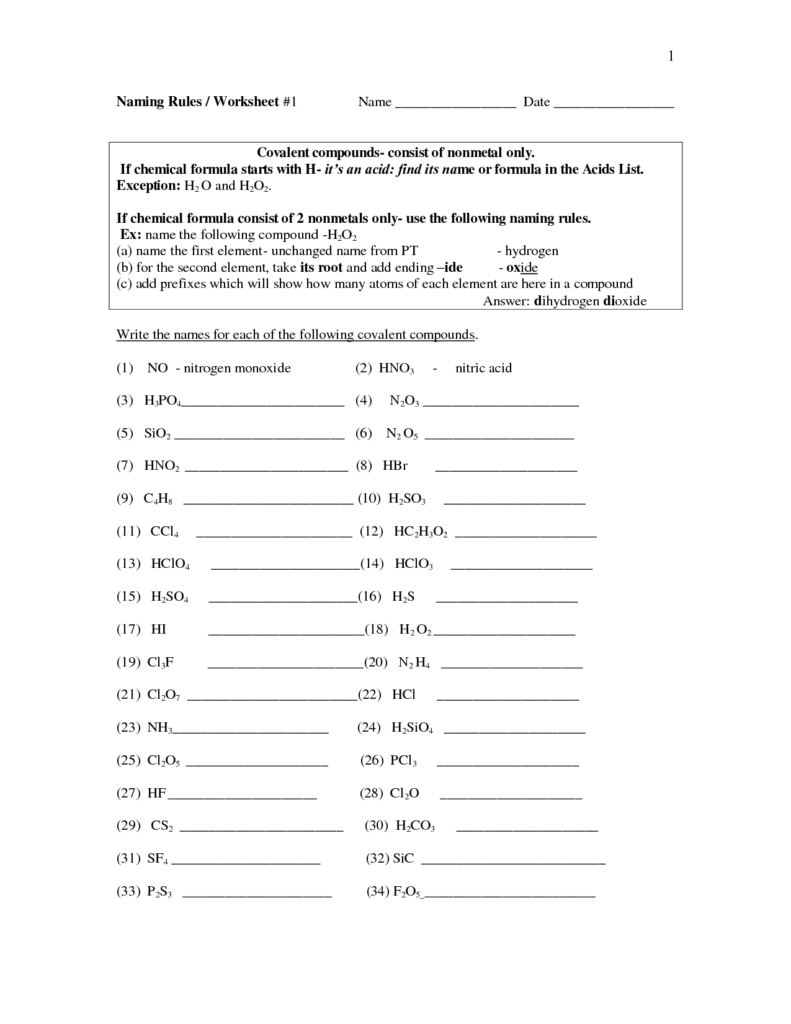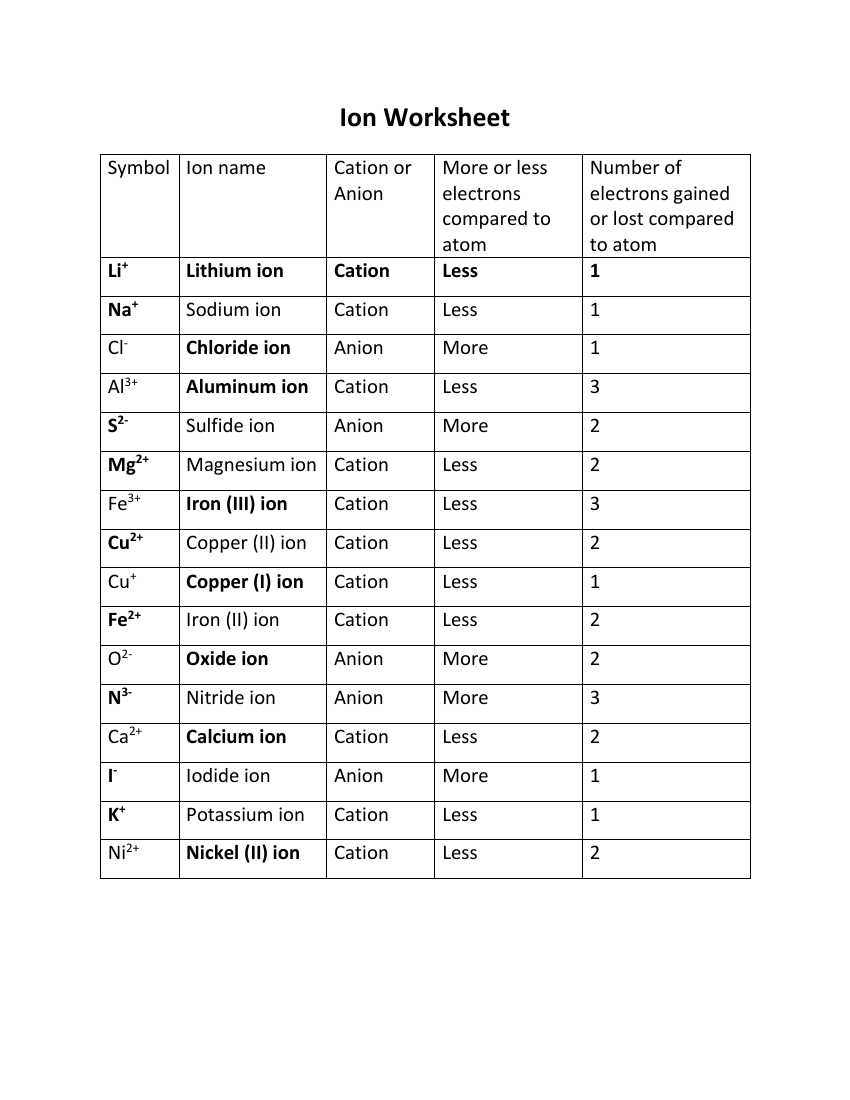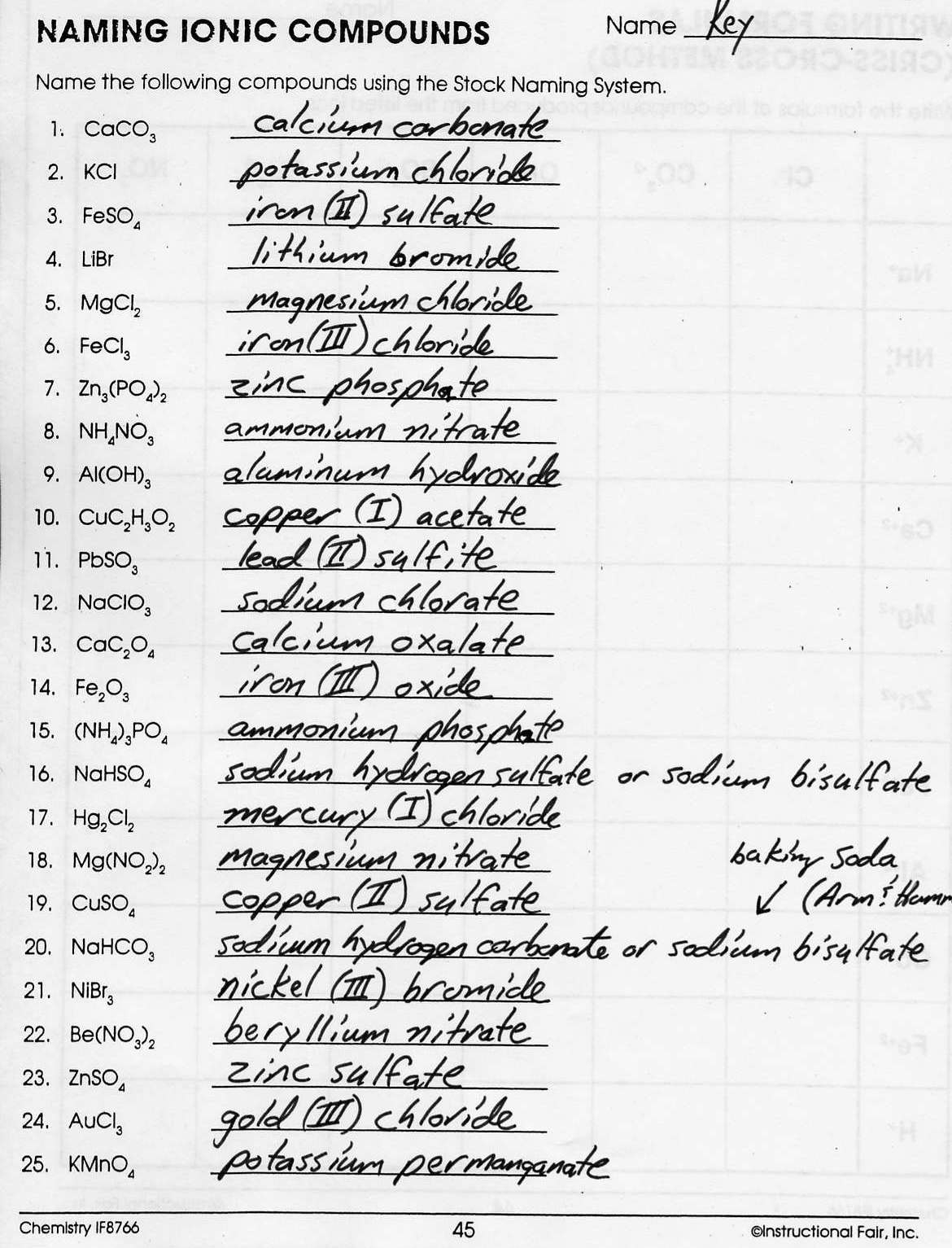Ion Practice Worksheet Answers - Describe how sizes of ions change as you move from the most positively charged ion to the most negatively charged ion in an isoelectronic series. Read each question or statement and respond in your notebook. Ionic bonds • ionic bonds form between _____ and _____. Worksheet 5.1 writing and naming ionic compounds with polyatomic ions and transition metals section a write the name of the ionic compounds. Use this naming polyatomic ions list and worksheet (answers provided) to quickly learn important chemical names and formulas. For each element below, state (i) the number of valence electrons in the atom, (ii). • in naming simple ionic compounds, the _____ is always first, the _____ second (e.g., sodium. This worksheet will help them visually understand how ions are formed, and give some practice on writing ion notation.
Ionic bonds • ionic bonds form between _____ and _____. Read each question or statement and respond in your notebook. Worksheet 5.1 writing and naming ionic compounds with polyatomic ions and transition metals section a write the name of the ionic compounds. • in naming simple ionic compounds, the _____ is always first, the _____ second (e.g., sodium. Use this naming polyatomic ions list and worksheet (answers provided) to quickly learn important chemical names and formulas. Describe how sizes of ions change as you move from the most positively charged ion to the most negatively charged ion in an isoelectronic series. This worksheet will help them visually understand how ions are formed, and give some practice on writing ion notation. For each element below, state (i) the number of valence electrons in the atom, (ii).
Use this naming polyatomic ions list and worksheet (answers provided) to quickly learn important chemical names and formulas. • in naming simple ionic compounds, the _____ is always first, the _____ second (e.g., sodium. Describe how sizes of ions change as you move from the most positively charged ion to the most negatively charged ion in an isoelectronic series. Read each question or statement and respond in your notebook. This worksheet will help them visually understand how ions are formed, and give some practice on writing ion notation. For each element below, state (i) the number of valence electrons in the atom, (ii). Ionic bonds • ionic bonds form between _____ and _____. Worksheet 5.1 writing and naming ionic compounds with polyatomic ions and transition metals section a write the name of the ionic compounds.
Ion Worksheets
Describe how sizes of ions change as you move from the most positively charged ion to the most negatively charged ion in an isoelectronic series. For each element below, state (i) the number of valence electrons in the atom, (ii). Ionic bonds • ionic bonds form between _____ and _____. • in naming simple ionic compounds, the _____ is always.
Ionic And Covalent Bonding Practice Worksheet
Worksheet 5.1 writing and naming ionic compounds with polyatomic ions and transition metals section a write the name of the ionic compounds. This worksheet will help them visually understand how ions are formed, and give some practice on writing ion notation. • in naming simple ionic compounds, the _____ is always first, the _____ second (e.g., sodium. Ionic bonds •.
10++ Ions Worksheet Answer Key Worksheets Decoomo
Ionic bonds • ionic bonds form between _____ and _____. This worksheet will help them visually understand how ions are formed, and give some practice on writing ion notation. • in naming simple ionic compounds, the _____ is always first, the _____ second (e.g., sodium. Read each question or statement and respond in your notebook. Worksheet 5.1 writing and naming.
10++ Ions Worksheet Answer Key Worksheets Decoomo
Worksheet 5.1 writing and naming ionic compounds with polyatomic ions and transition metals section a write the name of the ionic compounds. For each element below, state (i) the number of valence electrons in the atom, (ii). • in naming simple ionic compounds, the _____ is always first, the _____ second (e.g., sodium. Ionic bonds • ionic bonds form between.
Ion Formation Worksheet Answers
Read each question or statement and respond in your notebook. • in naming simple ionic compounds, the _____ is always first, the _____ second (e.g., sodium. Ionic bonds • ionic bonds form between _____ and _____. Use this naming polyatomic ions list and worksheet (answers provided) to quickly learn important chemical names and formulas. Worksheet 5.1 writing and naming ionic.
Binary Ionic Compound Practice Worksheet
This worksheet will help them visually understand how ions are formed, and give some practice on writing ion notation. Use this naming polyatomic ions list and worksheet (answers provided) to quickly learn important chemical names and formulas. Describe how sizes of ions change as you move from the most positively charged ion to the most negatively charged ion in an.
Practice Basic Ionic Compounds Answer Key
For each element below, state (i) the number of valence electrons in the atom, (ii). Use this naming polyatomic ions list and worksheet (answers provided) to quickly learn important chemical names and formulas. Worksheet 5.1 writing and naming ionic compounds with polyatomic ions and transition metals section a write the name of the ionic compounds. • in naming simple ionic.
Polyatomic Ions Worksheet Answer Key Polyatomic Practice Exams
Worksheet 5.1 writing and naming ionic compounds with polyatomic ions and transition metals section a write the name of the ionic compounds. For each element below, state (i) the number of valence electrons in the atom, (ii). Read each question or statement and respond in your notebook. • in naming simple ionic compounds, the _____ is always first, the _____.
Ion Worksheet with Answers Science 7th Grade
• in naming simple ionic compounds, the _____ is always first, the _____ second (e.g., sodium. Worksheet 5.1 writing and naming ionic compounds with polyatomic ions and transition metals section a write the name of the ionic compounds. For each element below, state (i) the number of valence electrons in the atom, (ii). This worksheet will help them visually understand.
Formulas Of Ionic Compounds Worksheet Answers
Read each question or statement and respond in your notebook. Use this naming polyatomic ions list and worksheet (answers provided) to quickly learn important chemical names and formulas. For each element below, state (i) the number of valence electrons in the atom, (ii). Ionic bonds • ionic bonds form between _____ and _____. This worksheet will help them visually understand.
Ionic Bonds • Ionic Bonds Form Between _____ And _____.
Read each question or statement and respond in your notebook. Use this naming polyatomic ions list and worksheet (answers provided) to quickly learn important chemical names and formulas. Worksheet 5.1 writing and naming ionic compounds with polyatomic ions and transition metals section a write the name of the ionic compounds. This worksheet will help them visually understand how ions are formed, and give some practice on writing ion notation.
For Each Element Below, State (I) The Number Of Valence Electrons In The Atom, (Ii).
Describe how sizes of ions change as you move from the most positively charged ion to the most negatively charged ion in an isoelectronic series. • in naming simple ionic compounds, the _____ is always first, the _____ second (e.g., sodium.








